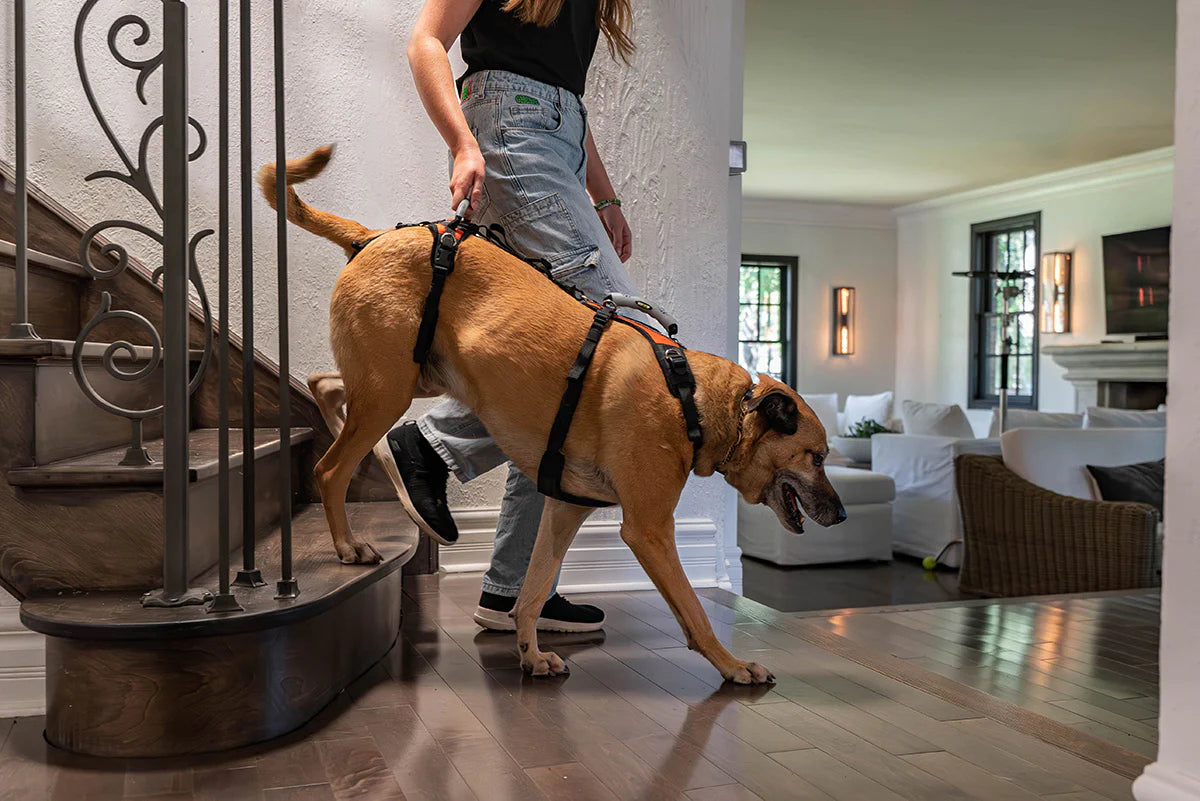Spinal Strokes in Dogs: Causes, Symptoms, and Treatment

Spinal strokes, also known as fibrocartilaginous embolism (FCE) or ischemic myelopathy, are relatively rare but potentially severe health events that can affect dogs. This condition can cause a wide range of symptoms, from mild weakness to complete paralysis, and may require extensive treatment to manage.
To ensure your dog gets the appropriate care, it's crucial to understand what spinal strokes are, their causes, and the best treatment options available. In this article, we will delve into the details of spinal strokes in dogs, discussing their causes, symptoms, and treatment options.
What is a Spinal Stroke in Dogs?
Before we examine the causes and symptoms of spinal strokes, it's essential first to define this condition and differentiate it from other types of strokes dogs can experience.Defining Spinal Strokes
A spinal stroke, or FCE, is a sudden and typically non-progressive injury to the spinal cord caused by a blockage of the blood vessels that supply it. This blockage leads to ischemia (lack of oxygen and nutrients) in the affected area, resulting in nerve damage and, consequently, various neurological symptoms. It's important to note that while spinal strokes can be severe, they are generally not life-threatening if promptly and correctly managed.
When a spinal stroke occurs, it can affect different parts of the body depending on the location of the blockage. For example, if the blockage occurs in the thoracic region of the spinal cord, the hind legs may be affected, while a blockage in the cervical region can cause weakness in all four legs. In some cases, the dog may lose the ability to control bladder and bowel function.
Causes of Spinal Strokes in Dogs
While the exact cause of a spinal stroke may not always be identifiable, veterinary experts have identified several possible contributing factors. These include vascular issues, trauma, infections, and underlying health conditions.Vascular Issues
Blood clotting disorders, arteriosclerosis (hardening and narrowing of the arteries), and other vascular abnormalities can lead to the formation of clots or blockages that disrupt blood flow to the spinal cord. These issues can cause a spinal stroke when oxygen and nutrients can no longer reach the nervous tissue, leading to ischemia and nerve damage.Trauma or Injury
Physical trauma, such as a car accident or a fall, can cause a spinal stroke if it injures the blood vessels supplying the spinal cord. Immediate or delayed swelling and inflammation can also exacerbate the injury, increasing the likelihood of a spinal stroke.Infections and Inflammation
Some infections and inflammatory conditions, such as bacterial meningitis or diskospondylitis, can lead to spinal stroke in dogs. These illnesses cause inflammation that can damage the blood vessels, disrupt blood flow, and lead to ischemia.Underlying Health Conditions
Various systemic health issues, such as cancer, autoimmune diseases, and metabolic disorders, can increase a dog's susceptibility to spinal strokes. In some cases, these conditions can cause secondary problems, like inflammation or increased blood clotting, contributing to spinal stroke risk.Recognizing the Symptoms of Spinal Strokes in Dogs
Early recognition of spinal stroke symptoms is crucial for prompt and appropriate treatment. The symptoms can range in severity and duration and may include the following.Sudden Onset of Weakness or Paralysis
One of the most notable symptoms of a spinal stroke in dogs is the sudden onset of weakness or paralysis in the limbs. Depending on the location of the spinal stroke, this symptom can affect one or multiple legs and may be more pronounced on one side of the body.Pain and Discomfort
While some dogs with spinal stroke show no signs of pain or discomfort, others may display signs of distress, such as vocalizing, panting, or restlessness. Pain may be more pronounced when touching or handling the affected area, and the dog may be reluctant to move if it causes discomfort.Changes in Gait and Coordination
Dogs suffering from a spinal stroke may exhibit changes in their gait or coordination, such as stumbling, staggering, or crossing their limbs when walking. These symptoms are a reflection of the nerve damage and resulting loss of communication between the brain and limbs.Loss of Bladder and Bowel Control
Depending on the severity and location of the spinal stroke, some dogs may lose bladder and bowel control. This symptom occurs when the nerve damage affects the communication between the spinal cord and the muscles controlling elimination.Diagnosing Spinal Strokes in Dogs
A thorough veterinary evaluation is necessary to diagnose a spinal stroke accurately and rule out other potential causes of the observed symptoms. This examination may involve several diagnostic methods, such as imaging techniques, blood tests, and other diagnostic tools.Veterinary Examination
A veterinarian will typically begin the diagnostic process by conducting a comprehensive physical and neurological examination of the dog. This evaluation will identify any abnormalities and assess the severity and extent of the symptoms.Imaging Techniques
Imaging studies, such as x-rays, computed tomography (CT) scans, and magnetic resonance imaging (MRI), can help visualize the spine and identify the presence of a spinal stroke or other underlying issues, like fractures or tumors. MRI is currently the gold standard for diagnosing FCE in dogs, due to its ability to provide detailed images of the spinal cord and surrounding structures.Blood Tests and Other Diagnostic Tools
Blood tests, urine tests, and cerebrospinal fluid (CSF) analysis may be performed to help identify underlying causes of the spinal stroke, such as infections, inflammation, or metabolic disorders. These tests can also help rule out other potential causes of the symptoms, enabling a more accurate diagnosis.Treatment Options for Spinal Strokes in Dogs
Once a spinal stroke has been diagnosed, various treatment options can help manage the condition and improve the long-term prognosis for affected dogs. These options include medications, physical therapy, surgical interventions, and alternative therapies.Medications and Pain Management
Nonsteroidal anti-inflammatory drugs (NSAIDs), steroids, or other pain-relief medications may be prescribed to help manage pain and inflammation associated with spinal strokes. If an identifiable cause, such as infection or blood clotting disorder, is identified, additional medications may be prescribed to address the underlying issue.Physical Therapy and Rehabilitation
Physical therapy and rehabilitation play a critical role in the recovery process for dogs with spinal stroke. These therapies aim to restore function, prevent muscle atrophy, and improve strength and mobility through various exercises and modalities. Working closely with a certified canine rehabilitation therapist can yield the best results for your dog.Surgical Interventions
While surgical interventions are not typically required for spinal strokes, they may be necessary if another underlying issue, such as a fracture or tumor, is discovered during the diagnostic process. In these cases, surgery will address the underlying issue, potentially improving the prognosis and overall recovery of the dog.Alternative Therapies
Alternative therapies, such as acupuncture, laser therapy, and massage, may be beneficial in complementing traditional treatments for spinal strokes in dogs. These therapies can help manage pain, promote healing, and enhance overall well-being.Mobility Assistance for Severely Affected Pets
A spinal stroke can lead to severe mobility issues and, in some cases, complete paralysis of the limbs. Providing proper mobility support is crucial for maintaining your pet's quality of life and preventing further damage. One effective solution is the use of a dog wheelchair.Supporting Mobility With a Dog Wheelchair
A dog wheelchair is designed to support the weight of your pet's hind legs, front legs, or provide full limb support, allowing them to move around with ease. The device consists of a lightweight frame, harness system, and wheels, which work together to provide stability and support. With a wheelchair, your pet can regain their independence and continue walking, playing, and exploring their environment.Preventing Further Damage
When a dog is unable to use its limbs correctly, it can lead to muscle atrophy, joint problems, and pressure sores. A wheelchair alleviates these issues by redistributing the weight and minimizing the strain on the affected limbs. This not only helps protect the limbs from further damage but also promotes better blood circulation. Additionally, using a wheelchair can help prevent complications associated with dragging the limbs, such as abrasions and skin irritation.Customization for Optimal Comfort and Fit
Dog wheelchairs, like the ones we offer at K9 Carts, can be customized to fit your pet's specific needs and body size. This ensures that the wheelchair provides optimal support and comfort, allowing your pet to move around with ease and confidence.
In conclusion, understanding the causes, symptoms, and treatment options for spinal strokes in dogs is essential for ensuring your dog receives appropriate care if faced with this condition. By recognizing the signs and working closely with your veterinarian and rehabilitation specialists, you can help improve the prognosis and quality of life for your canine companion.








